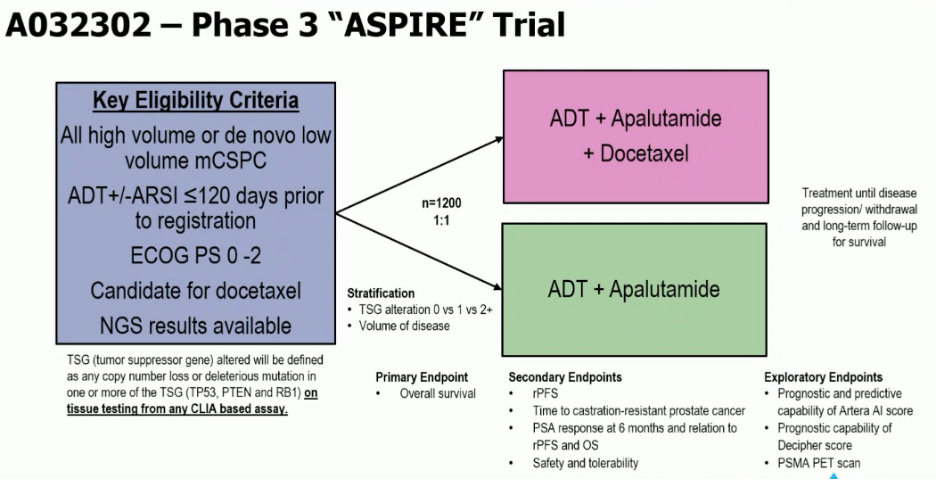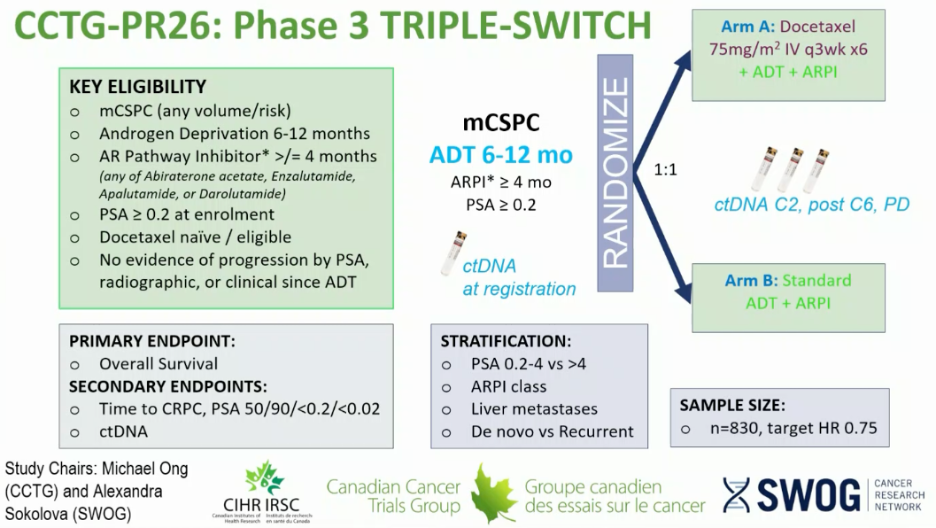(UroToday.com) The 2024 European Society for Medical Oncology (ESMO) Annual Congress held in Barcelona, Spain was host to a proffered paper session for prostate cancer. Dr. Rana McKay delivered the discussant session for CONTACT-02 and the post-hoc analysis of STAMPEDE Docetaxel assessing Decipher® as a potential predictive biomarker for overall survival in metastatic hormone sensitive prostate cancer (mHSPC) patients receiving docetaxel doublet therapy.

Starting off with her discussion of the CONTACT-02 trial, Dr. McKay noted that there have been numerous trials that have evaluated novel treatment strategies in mCRPC patients with disease progression following treatment with an androgen receptor pathway inhibitor (ARPI). These include 177Lu-PSMA-617 in the PSMAfore trial, enzalutamide + docetaxel in PRESIDE, 177Lu-PSMA-617 in the post-ARPI and taxane setting in VISION, and cabazitaxel in the post-ARPI and docetaxel setting in CARD.

What is the activity of single agent cabozantinib in mCRPC? Cabozantinib monotherapy was evaluated in the COMET-1 trial of heavily pre-treated mCRPC patients with disease progression following docetaxel and ARPI therapy, bone metastases, and high opioid use at baseline (66% of cohort). Cabozantinib demonstrated a progression-free survival benefit of almost 3 months, but no significant overall survival benefit.1 COMET-2, which was designed to compare cabozantinib and mitoxantrone, was terminated early because cabozantinib did not demonstrate a survival benefit in the companion COMET-1 trial.2

The combination of cabozantinib + atezolizumab was evaluated in the phase Ib COSMIC-021 trial. This combination was associated with an objective response rate of 15–23%. The progression-free survival benefit was 5.5 months, which is similar to that observed in COMET-1. As such, the value of atezolizumab addition in this setting was difficult to determine.3

The CONTACT-02 study design is summarized below:

This trial demonstrated a significant progression-free survival benefit (12 versus 5.6 months; HR: 0.43, 95% CI: 0.33–0.54), but no overall survival benefit (HR: 0.98, 95% CI: 0.76–1.27). The use of an ARPI switch as the control arm has come into question. And while this is no longer standard of care therapy in the post-ARPI mCRPC setting, the reality is that up to 70% of patients still receive an ARPI switch following progression on the alternate ARPI.4 Sequential ARPI is being utilized as the control arm in ongoing trials:
- MK5684-003
- ECLIPSE 177Lu-PSMA-I&T
While CONTACT-2 met one of its co-primary endpoints (radiographic progression-free survival), the reality is that a radiographic progression-free survival benefit rarely results in regulatory drug approval in mCRPC. These approvals are typically dependent on an evaluation of the totality of the data of rPFS, OS, safety, toxicity, and quality of life.
CONTACT-02 included mCRPC patients with adverse risk features. ~40% had visceral metastases, of which 23% total were liver metastases. 22% had received prior docetaxel. 74% received their 1st ARPI in the mCRPC setting, and the median duration of the 1st ARPI was ~12 months only. When compared to other trials, we see that this duration on first ARPI is short and likely reflects underlying aggressive biology in these patients.

When looking at the progression-free survival Kaplan Meier curves, Dr. McKay noted that there was a significant drop-off of patients near the initial scan assessment (~40% in the control arm). The curves begin to separate at 3 months but converge over time. This may reflect treatment resistance to the study drug combination and reduction in dose intensity (73% with dose hold and 49% with dose reduction of cabozantinib).

With regards to the overall survival Kaplan Meier curves, there was an initial separation of the overall survival curves that signifies an initial treatment benefit. These curves converge and later overlap at 3 months. This may reflect the fact that 51% and 44% of patients in the treatment and control arms did not receive systemic treatment, as well as a diminishing effect over time. Additionally, if we focus on the median overall survival of patients in both cohorts, there was a shorter overall survival than would be expected in a taxane-naïve mCRPC cohort.

Overall survival subgroup analyses demonstrated that patients with bone and liver metastases appeared to derive a benefit. Older adults (HR: 1.49), those receiving ARPI in the mCSPC setting (HR: 1.24), and those with Gleason Score <8 disease (HR: 1.15) do not seem to derive a benefit.

The subgroup analysis in patients with liver metastases was pre-planned. Dr. McKay argued that patients with liver metastases are an unmet need given that these patients do poorly with ARPIs, are associated with worse overall survival compared to other sites of metastases, and these patients have limited treatment options.

Dr. McKay’s summary of CONTACT-02 and its impact on clinical management was as follows:
- The CONTACT-2 trial enrolled a very distinct patient population from other mCRPC studies with the eligibility requirement for measurable disease.
- The trial included a poor risk population with a high degree of visceral metastases and short duration of prior ARPl use.
- While the CONTACT-02 trial was a positive trial with improved progression-free survival compared to ARPI treatment, no overall survival benefit was observed.
- Patients with liver metastases and prostate cancer remain an unmet need and additional treatments are warranted for these individuals.
Next, Dr. McKay moved on to discuss the results of the ad hoc STAMPEDE trial that identified Decipher as a predictive biomarker of an overall survival benefit with docetaxel addition to ADT in mHSPC patients.

Survival outcomes are heterogenous in mHSPC patients receiving treatment intensification. As such, Dr. McKay argued that biomarker risk stratification to optimize treatment selection is essential in this setting.

There are numerous factors impacting the decision to recommend docetaxel for mHSPC patients, including disease-, clinical-, and drug-related factors.

Can biomarkers help us identify subgroups which benefit from docetaxel chemotherapy in mHSPC patients?

PAM50 and decipher were both found to be predictive of a docetaxel benefit via transcriptome profiling of primary prostate tumors from the CHAARTED study in mHSPC patients.

As seen below, Decipher Score was prognostic of overall survival in both M0 and M1 patients.

The Decipher score was predictive of an overall survival benefit in the overall, including both low- and high-volume groups. Dr. McKay argued that this is likely of most clinical significance in the low-volume group where treatment intensification is most often debated. These results suggest that low volume patients with lower Decipher scores may be considered for ADT monotherapy, particularly in settings, such as high comorbidity burden, frailty, etc.

She noted that biomarker risk stratification, beyond routine clinical, imaging, and pathologic variables, is becoming more prominent in the metastatic setting. The multimodal artificial intelligence (MMAI) score was shown to be prognostic of prostate cancer-specific mortality to ADT, docetaxel, and abiraterone from STAMPEDE.

Numerous ongoing trials are incorporating/assessing the prognostic and predictive utility of MMAI Artera AI scores, including the phase III ASPIRE and TRIPLE-SWITCH trials.


She concluded as follows regarding the STAMPEDE Decipher prognostic/predictive study:
- Decipher was prognostic and predictive of outcomes to docetaxel chemotherapy from STAMPEDE.
- Limitations of this analysis included the lack of integration of other prognostic variables (e.g., MMAI), and that the dataset was limited to patients receiving docetaxel + ADT, which has limited utilization in modern era.
- Does this change my practice come Monday morning? - Possibly, particularly for low volume patients debating the decision for triplet therapy.
- Prospective validation in ongoing phase III trials is warranted.
Presented by: Rana McKay, MD, Associate Professor, Department of Medicine, University of California, San Diego, CA
Written by: Rashid Sayyid, MD, MSc – Robotic Urologic Oncology Fellow at The University of Southern California, @rksayyid on Twitter during the 2024 European Society of Medical Oncology (ESMO) Annual Meeting, Barcelona, Spain, Fri, Sept 13 – Tues, Sept 17, 2024.
References:
- Smith M, de Bono J, Sternberg J, et al. Phase III Study of Cabozantinib in Previously Treated Metastatic Castration-Resistant Prostate Cancer: COMET-1. J Clin Oncol. 2016; 34(25):3005-13.
- Basch EM, Scholz M, de Bono JS, et al. Cabozantinib Versus Mitoxantrone-prednisone in Symptomatic Metastatic Castration-resistant Prostate Cancer: A Randomized Phase 3 Trial with a Primary Pain Endpoint. Eur Urol. 2019; 75(6):929-37.
- Agarwal N, McGregor B, Maughan BL, et al. Cabozantinib in combination with atezolizumab in patients with metastatic castration-resistant prostate cancer: results from an expansion cohort of a multicentre, open-label, phase 1b trial (COSMIC-021). Lancet Oncol. 2022; 23(7):899-909.
- Freedland SJ, Davis M, Epstein AJ, Arondekar B, Ivanova JI. Real-world treatment patterns and overall survival among men with Metastatic Castration-Resistant Prostate Cancer (mCRPC) in the US Medicare population. Prostate Cancer Prostatic Dis. 2024; 27(2):327-33.


